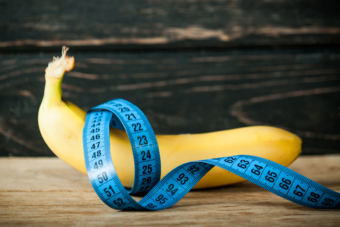Does Hand and Foot Size Really Correlate with Penile Length?
 Given that public nudity is generally considered unacceptable in most of the modern world (and if you’re wondering, see: When Did Humans Start Wearing Clothes?), people have long tried to come up with other potential indicators to determine the size of a guy’s manhood without actually seeing it. A seemingly tried and true method for doing just this is to look at the size of the man’s hands and/or feet. But does hand and foot size really correlate to the length of the penis?
Given that public nudity is generally considered unacceptable in most of the modern world (and if you’re wondering, see: When Did Humans Start Wearing Clothes?), people have long tried to come up with other potential indicators to determine the size of a guy’s manhood without actually seeing it. A seemingly tried and true method for doing just this is to look at the size of the man’s hands and/or feet. But does hand and foot size really correlate to the length of the penis?
Nope.
Studies have consistently shown that the size of a guy’s feet or the overall size of their hands is not related to their member’s erect measurement. However, a man’s fingers do give a strong clue as to their probable penis size- but the overall length of the fingers is not what’s important here.
For instance, a study published in the Asian Journal of Andrology in 2011 found that the ratio between the 2nd and 4th digits on the hands strongly correlates with the overall length of an individual’s penis. Specifically, Dr. Ho Choi and et al. state;
Univariate and multivariate analysis using linear regression models showed that…. only digit ratio was a significant predictive factor for stretched penile length…
 In a nutshell, the lower the ratio- how much shorter the index finger is than the ring finger- the longer the penis will probably be when erect. (And if you’re wondering, flaccid penis length is not an accurate predictor of erect penis length.) More specifically, you can calculate your ratio by taking the length of your index finger (measured from the crease where it meets your hand, to the tip) and divide it by the length of your ring finger. The shorter your index finger is compared to the ring finger, the lower the ratio will be and, if you’re a man, the longer your penis probably is.
In a nutshell, the lower the ratio- how much shorter the index finger is than the ring finger- the longer the penis will probably be when erect. (And if you’re wondering, flaccid penis length is not an accurate predictor of erect penis length.) More specifically, you can calculate your ratio by taking the length of your index finger (measured from the crease where it meets your hand, to the tip) and divide it by the length of your ring finger. The shorter your index finger is compared to the ring finger, the lower the ratio will be and, if you’re a man, the longer your penis probably is.
So why does the ratio of the index and ring finger lengths correlate to erect penis length? In the beginning, female and male genitals are pretty much the same. This is because they develop from the same cluster of tissues (gonads). In males, somewhere around weeks 7-9 of gestation, the gonads begin secreting two hormones- Anti-müllerian hormone (AMH) and testosterone. AMH prevents the development of the ducts that eventually turn into the fallopian tubes, the uterus, and upper vagina.
Once the gonads begin secreting testosterone, some if it (around 5-10%) gets transformed into another hormone called dihydrotestosterone. Both testosterone and dihydrotestosterone will attach to androgen receptors, which affect the growth and development of many different body systems.
Notable here, dihydrotestosterone attaches to androgen receptors on tissues that eventually develop and combine into the penis and scrotum. Low levels of this within the womb, or later during puberty, may result in an underdeveloped or malformed penis.
So to sum up here, penile growth in the womb is stimulated and affected by testosterone, dihydrotestosterone, and androgen receptors. Circulating amounts of the two hormones, combined with the associated androgen receptor stimulation, will determine penis size.
So what about fingers? Circulating testosterone in the womb will affect other body parts as well- pertinent to the topic at hand, including the ratio between the 2nd and 4th digits (index and ring fingers).
Why does testosterone affect digits differently? For that, I’ll have to get a little more technical, but essentially the activity mediated by androgen receptors, and estrogen receptor-a, is higher in your ring finger compared to your index finger. This is regulated by the structure of genes controlling the process for the bone growth of your fingers, called endochondral ossification. The spread of chondrocytes will determine the length of your finger, and this expansion is higher in the ring finger compared to the index finger.
When you decrease the activation of androgen receptors during the narrow window of digit development (usually completed by week 13 of gestation), you will decrease the length of your ring finger. This activation is attributed to amount of testosterone and DHT circulating throughout the tiny fetus. Conversely, if you decrease the activity of the receptor estrogen-a (the ones being stimulated more when you’re female), you will get a longer ring finger.
Based on this physiology, it has been long known that you can predict prenatal hormone exposure based on the ratio of these two fingers. Since both penile length and the ratio of the ring and index finger is basically a result of the amount of testosterone and DHT circulating in utero, there is a correlation between that ratio and the length of a man’s favorite appendage.
As you might have guessed from all this, the ratio between the lengths of one’s index and ring fingers is usually quite different in men and women- men tend to have shorter index fingers than ring fingers; women tend to have their index fingers either the same length or longer than their ring fingers.
If you liked this article, you might also enjoy our new popular podcast, The BrainFood Show (iTunes, Spotify, Google Play Music, Feed), as well as:
- How Erections Work
- Avoiding Being Sued With the “Small Penis” Rule
- When Did Men Start Getting Circumcised?
- Why Do We Still Have Pubic and Armpit Hair?
- How Dick Came to be Short for Richard
Bonus Facts:
- Beyond the stereotype of penis size correlating to hand or feet size being false, the just as prevalent stereotype concerning race and penis size also appears to be untrue; scientifically rigorous studies looking at penis length and race to date have consistently shown no statistically significant difference here.
- While there are some minor differences from study to study, reviews have shown that the average flaccid penis size at birth is around 1.39 inches (3.55cm); the average circumference at this time is 1.72 inches (4.38 cm). By the age of 19, the average flaccid length is 3.61 inches (9.1 cm). The average erect length is 5.17 inches (13.1 cm). The average erect circumference is 4.59 inches (11.6 cm). After this time, penile length is pretty much set for life for most. (And it should be noted here that males measuring their own penises almost universally seem to measure themselves much larger than when researchers do it…)
- The question of what is more influential on penile development, puberty or prenatal testosterone levels, hasn’t yet been fully studied. Several researchers point out, however, that those who go through normal puberty will have widely varying penis sizes, perhaps pointing to prenatal testosterone being the more crucial factor.
- Penile length isn’t the only thing digit ratio can predict. Since testosterone and DHT control the development of several body systems and processes, digit ratio can be a predictor of a wide range of physiological and psychological conditions. These include things like athletic ability, sexual orientation, fertility, and some sex based ailments such as prostate and uterine problems. Lower digit ratios tend to occur in people with more aggressive behaviors, and those with them are less likely to suffer from eating disorders. People with higher digit ratios tend to be more agreeable. Research has also indicated that straight women and gay men who have higher ratios tend to prefer partners who are more masculine.
| Share the Knowledge! |
|







My finger length ratio is different on my left and my right hand. I’ve been told that the right hand is more amenable to prenatal testosterone.
There’s an anecdote I heard about some very tall basketball player who was asked by a woman, “Is the whole of you in relation to your height?”
“No, ma’am,” he replied.”Otherwise I’d be ten feet tall.”